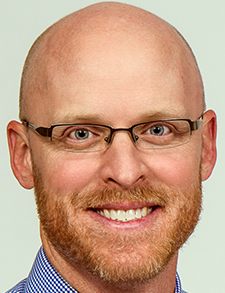
Employee retention sign and figurines on the memo sticks.
As he stood before the audience talking about the high rate at which physicians are leaving health care, and the challenges to retaining them, Alan Hathcock, MD, MPH, FHM, chief executive officer and medical director of Northern Colorado Hospitalists in Fort Collins, Colo., made a guess.
“I’m sure each of you knows somebody who’s gone through a similar journey,” he said in a session at SHM Converge in March. “Maybe some of you in this audience right now are clinicians who are going through that journey or have thought about it.”
“This is a great loss to the community,” he added. “This, really, is why it’s so important that we re-imagine physician retention and refocus our strategies and tactics around this topic.”
Dr. Hathcock’s talk, at times, struck a note of grief on the retention struggles the field is facing. Hospitalist groups cannot excel without retaining their physicians, physicians can find themselves losing their passion for the career they once loved, and patients can lose experienced health professionals to care for them.

Dr. Hathcock
But he also struck notes of hope: There are ways to ensure that physicians find their jobs satisfying and want to stay in their jobs—it’s just a matter of putting best practices into place, he said.
The numbers paint a picture of an urgent situation. A 2022 report by Elsevier Health found that 47% of U.S. health care workers were planning to leave their role in two to three years.1 Another 2022 report, in the Journal of the American Medical Association, reported that 20% of physicians said they planned to leave their current practice within two years.2
A Mayo Clinic report found that 65% of doctors are experiencing at least one symptom of burnout, which was a big rise from before the COVID-19 pandemic.3 The study also found a sizable gap between physicians and administrators and managers on the cause for burnout symptoms: 40% of physicians said they thought it was caused mostly or totally by their current employer, while only 19% of administrators and managers thought this. A much higher percentage of administrators and managers thought it was caused equally by management and the nature of being a physician, according to the report.
In hospital medicine, a 2022 survey found that 50% of hospitalists said they were very satisfied with their jobs in 2019, but only 20% said this in 2022. In 2018, 11% said they were dissatisfied with hospital medicine, while 18% said so in 2022.
Dr. Hathcock called these “pretty alarming data.”
From strictly a dollars-and-cents perspective, having hospitalists leave their positions is a bad thing. One publication estimated the cost of replacing a single hospitalist at $60,000, but this number could be higher. Dr. Hathcock said his institution puts that cost at $85,000 to $90,000.
“It’s expensive—any way you cut it,” he said.
Physicians leave their jobs for a variety of reasons that might sound familiar: Undesirable schedules, low compensation, unsustainable clinical workloads, a mismatched personal or group culture and values, a work-life imbalance, night and weekend work, administrative burdens, as well as family needs and location.
Most of all—to put it plainly—“people leave bad managers,” Dr. Hathcock said.
Why do they stay in their jobs? A sense of community, transparent communication, a feeling of agency and participation, compensation and benefits, flexible scheduling, manageable workloads, physician retention programs, reduced cognitive and administrative burden, time off, gratitude and recognition, and the ability to have a life outside medicine.
Dr. Hathcock reviewed 10 strategies to help retain physicians and keep turnover down:
1. Shared mission: A corporate mission statement is a must, and people in the organization have to know and understand it, he said, and it has to be put into practice.
“Corporate mission statements don’t really matter unless you want to be a great leader,” Dr. Hathcock said, quoting the title of a 2017 article on the topic.
This statement should say who an organization is, articulate its purpose, and give reasons why a physician should want to be on that team, he said.
2. Building the team: “Focus on getting the right folks from the outset by making sure the people you hire believe in your mission,” Dr. Hathcock said. This involves reviewing all parts of the recruiting and hiring process, and having a firm bar for clinical competence, he said.
“Don’t interview or hire anybody that is below your clinical standards, ever,” he said. “Period. Don’t do it.”
3. Onboarding: This is crucial, he said, because “first impressions stick.”
Onboarding starts the moment a contract is signed, he said. New hires should be guided through the organization’s processes, and it’s a good idea to pair them with an orientation liaison physician. A mentor for the first year is also a key component, he said. Managers should also get to know family and partners.
4. Culture: An environment needs to be created for people to get to know one another and build a community—organizations should strive for a “culture of helping,” Dr. Hathcock said.
“Do those things that show that you’re valuing and investing in your docs and providers,” he said. “Nothing shows investment like asking for feedback and then doing something about it.”
He also emphasized “zero tolerance for toxic, unprofessional behavior.”
“One drop of oil poisons the well,” he said. “And it will.”
5. Scheduling and staffing: Reevaluating how schedules and rounding are done can be revealing, with a focus on flexibility, how schedule requests are submitted, surveys to identify pinch points, and exploring other groups’ service models.
“If people don’t get their requests and the schedule has no flexibility, they’re gonna leave, I promise,” Dr. Hathcock said. “If people are overloaded with too many patients, they’re gonna leave, guaranteed.”
6. Continuous improvement: Be in a constant state of revision and refinement of the work environment and efficiency. This includes clinical processes and workflows and answering whether extra “asks” actually add value.
Always refining is the “key to sustainability,” he said.
7. Clinical excellence: There should be a “clear, unwavering focus on high-quality patient care and professionalism,” Dr. Hathcock said. This includes patient outcomes, but also clinical education and quality improvement. A quality focus should be considered during recruiting and can be incentivized with bonus metrics, he said.
8. Adapting to change: Lessons can be drawn from the COVID-19 crisis, he said. Organizations need to have a surge and crisis staffing plan, with a system of back-ups. New hires should expect that change will happen, he said.
“We try to instill that mindset from the beginning so that people can hopefully, when the time comes, know that we’re trying to change to fix the process, not just change to change,” he said.
9. Compensation: This can’t be ignored, Dr. Hathcock said.
“Fair compensation is an integral part of hiring and retaining your physicians to some extent,” he said. “So, you check the box.” He added, “Don’t underestimate the value of benefits,” and bonuses.
10. Lead from the front: Being a clinician who then rises to leadership “tends to lend a little bit of trust and credibility” when leading clinicians, Dr. Hathcock said.
But this can also be done without having been a clinician, he said. It just requires “leading from the perspective of the front lines.
“Go to that front line, learn about the processes, so that people know that you understand them, and that’s your lens as you move forward, and you make decisions with your team.”
Tom Collins is a medical writer in Florida.
References
- Elsevier Health. Clinician of the future: Report 2022. Elsevier Health website. https://www.elsevier.com/__data/assets/pdf_file/0004/1242490/Clinician-of-the-future-report-online.pdf. Published March 15, 2022. Accessed May 21, 2023.
- Abbasi J. Pushed to their limits, 1 in 5 physicians intends to leave practice. JAMA. 2022;327(15):1435-7.
- Shanafelt TD, et al. Changes in burnout and satisfaction with work-life integration in physicians and the general US working population between 2011 and 2020. Mayo Clin Proc. 2022;97(3):491-506.